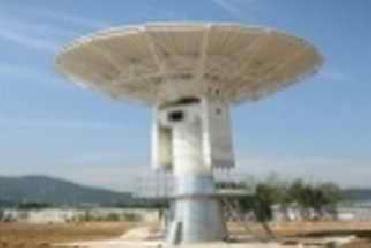
The image has been adjusted to our site design and is a part of the official logo of the IYA
PARIS (BNS): Nearly 135 nations across the globe are working together in the International Year of Astronomy 2009 (IYA 2009) to bring the Universe closer to Earth. The two-day official IYA2009 opening ceremony is scheduled to begin here on January 15.
The official slogan of the IYA2009 is "The Universe, Yours to Discover".
Catherine Cesarsky, International Astronomical Union President, said that nearly 135 countries have committed themselves to the Year, all pulling together toward the common aim of making astronomy accessible to the public. “IYA2009 will reinforce the links between science education and science careers, stimulating a long-term increase in student enrolment in the fields of science and technology and an appreciation for life-long learning,” Cesarsky said.
Nobel Laureates and scientists are expected to take part in the event. The event will be telecast live to help reach scientists working in remote locations. Many countries too are holding their own opening ceremonies in January and February, to mark the Year.
Many events have been planned through out the year. In a grand worldwide campaign involving more than 30 nations in 150 venues, the IYA2009 Solar Physics Group will help amateur stargazers set up their telescopes on pavements as well as in science centres, allowing passers-by observe the Sun using special safety equipment.
An official website released on the New Year’s Day, called the Cosmic Diary projects the daily lives of full-time astronomers. More than 50 bloggers, professionals from over 35 countries and employed by organisations such as ESO, NASA, ESA and JAXA have already begun producing content, writing about their lives, the work they conduct and the challenges they face. The public can access this to know what being an astronomer is really like, and how ground-breaking research is conducted. Another project, 365 Days of Astronomy, will publish one podcast per day over the entire year. The episodes will be written, recorded and produced by people around the world.
At a four-day event planned from April 2, a project titled 100 Hours of Astronomy will be taken up. One of the key goals of this project is to have as many people as possible look through a telescope, just as Galileo did for the first time 400 years ago.
IYA 2009 is also organising an exhibition called From Earth to the Universe (FETTU), which will bring large-scale astronomical images to a wide public audience in non-traditional venues such as public parks and gardens, art museums, shopping malls and metro stations. Over 30 countries around the world are currently in the development phase of FETTU projects, many with multiple locations. Some 15 countries plan to begin FETTU exhibitions within the first month of 2009, ranging in size from 25 to over 100 images on display. FETTU will be introduced to the global community at the Opening Ceremony at UNESCO headquarters in January 2009, officials said.
Disclosing further projects, the officials said that the World at Night is an IYA2009 Special Project that is producing and bringing to the public a collection of stunning photographs and time-lapse videos of the world's landmarks with the sky in the background. The World at Night is preparing more than 30 exhibitions and educational events around the world, they said.
One of IYA2009's aims is to raise awareness of light pollution, and how the beauty of the night sky is progressively being drowned out, particularly in urban areas. The project Dark Skies Awareness is tackling these issues head-on in a practical, inclusive manner.
One way in which it is doing this is by holding star-counting events, where the public are encouraged to see how many stars in a particular area of the sky are actually visible from their location. When compared with data from truly dark sites, the results are often very surprising! The "How Many Stars" event will run from January 2009, they said.
During 2009, the sky will provide some exciting events, including the longest total solar eclipse of the 21st century, occurring on 22 July 2009 and lasting 6 minutes 39 seconds over a narrow corridor through countries including India, Bangladesh and China. A strong shower of Leonid meteors is also expected in mid-November 2009, with forecasters predicting upwards of an incredible 500 shooting stars per hour. In mid-October in the northern hemisphere, Jupiter will be placed at dusk, a perfect time to show public the giant planet and its moons. These are an impressive sight through even a small amateur telescope, the officials said.
IYA2009 seeks to involve the public at large in its activities, and to this end amateur astronomers have been called upon to help organise and run events. Known for their enthusiasm, this army of helpers is growing every day, preparing to promote astronomy in a stunning variety of ways. In fact, so many thousands of people across the globe are already involved, they have formed the world's largest ever astronomy network.
The IYA2009 has been launched by the International Astronomical Union and the United Nations Educational, Scientific and Cultural Organisation under the theme, "The Universe, yours to discover".
 Previous Article
Previous Article Next Article
Next Article












The Indian Air Force, in its flight trials evaluation report submitted before the Defence Ministry l..
view articleAn insight into the Medium Multi-Role Combat Aircraft competition...
view articleSky enthusiasts can now spot the International Space Station (ISS) commanded by Indian-American astr..
view article